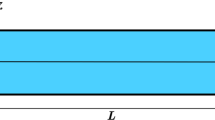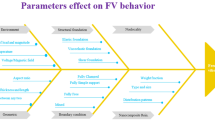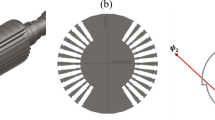Abstract
Previous studies on the vibration of a nanobeam in the presence of weak interacting forces have been limited to small- to moderate-amplitude vibrations where the effects of weak forces are not significant. In this study, the large-amplitude vibration of a nonlinear nanobeam in the presence of the van der Waals, Casimir, electrostatic and fringing forces was investigated. The Bubnov–Galerkin approach was employed to transform the governing partial differential equation of the nanobeam to a nonlinear ordinary differential equation (NODE) characterized by strong inertia and static nonlinearities. The NODE for the nanobeam vibration was solved using the continuous piecewise linearization method (CPLM). The ability of the CPLM algorithm to accurately predict the large-amplitude vibration of the nanobeam was verified by comparing its results with highly accurate numerical solutions and other approximate analytical solutions found in the literature. It was observed that the results of the CPLM algorithm agreed well with corresponding results of highly accurate numerical solution. Also, the CPLM produced more accurate results than the published approximate analytical solutions. Furthermore, the effects of the van der Waals force, Casimir force, electrostatic force and fringing force on the frequency response of the large-amplitude nanobeam were studied and it was found that an increase in any of the weak forces causes a significant reduction in the vibration frequency of the nanobeam. The study shows that the CPLM can be applied for accurate nonlinear analysis of the large-amplitude vibration of conservative systems with complex mixed-parity nonlinearities.










Similar content being viewed by others
Data Availability
This manuscript has no associated data.
References
Adomian GA (1988) Review of the decomposition method in applied mathematics. J Math Anal Appl 135:501–544
Amer TS, Moatimid GM, Amer WS (2022) Dynamical stability of a 3-DOF auto-parametric vibrating system. J Vib Eng Technol 28:1–36
Askari AR, Tahani M (2012) On the Response of Clamped–Clamped Nano-Electro- Mechanical Beam under Mechanical Shock Incorporating the Casimir Force. In: 2nd International Conference on Acoustics & Vibration (ISAV2012), Tehran, Iran, 26–27
Batra RC, Porfiri M, Spinello D (2006) Electromechanical model of electrically actuated narrow microbeams. J Microelectromech Syst 15(5):1175–1189
Bayat M, Bayat M, Pakar I (2014) Nonlinear vibration of an electrostatically actuated microbeam. Latin Am J Solids Struct 11:534–544
Big-Alabo A (2018) Periodic solutions of Duffing-type oscillators using continuous piecewise linearization method. Mech Eng Res 8(1):41–52
Big-Alabo A (2021) Energy-based criterion for testing the nonlinear response strength of strong nonlinear oscillators. J Appl Sci Environ Manag 25(2):225–231
Big-Alabo A, Ogbodo CO, Ossia CV (2020) Semi-analytical treatment of complex nonlinear oscillations arising in the slider-crank mechanism. World Scientific News 142:1–24
Big-Alabo A, Ossia CV (2020) Periodic solution of nonlinear conservative systems. In: Buzea CG, Agop M, Butler L (eds) Progress in relativity. IntechOpen, UK
Big-Alabo A, Ossia CV, Ekpruke EO, Ogbonnia CD (2022) Large-amplitude vibration analysis of a strong nonlinear tapered beam using continuous piecewise linearization method. J King Saud Uni Eng Sci 34(5):344–349
Durmaz S, Kaya MO (2012) High-order energy balance method to nonlinear oscillators. J Appl Mathemat. https://doi.org/10.1155/2012/518684
Ebaid AE, Ali E (2009) On a new aftertreatment technique for differential transformation method and its application to non-linear oscillatory systems. Internat J Nonlin Sci 8(4):488–497
Elıas-Zuniga A, Martınez-Romero O (2013) Accurate solutions of conservative nonlinear oscillators by the enhanced cubication method. Mathemat Problems Eng. https://doi.org/10.1155/2013/842423
Fu Y, Zhang J, Wan L (2011) Application of the energy balance method to a nonlinear oscillator arising in the microelectromechanical system (MEMS). Curr Appl Phys 11(3):482–485
Ghalambaz M, Ghalambaz M, Edalatifar M (2016) Nonlinear oscillation of nanoelectro-mechanical resonators using energy balance method: considering the size effect and the van der Waals force. Appl Nanosci 6:309–317
Hammad BK, Abdel-Rahman EM, Nayfeh AH (2010) Modeling and analysis of electrostatic MEMS filters. Nonlinear Dyn 60:385–401
He JH (1999) Homotopy perturbation technique. Comput Methods Appl Mech Eng 178(3/4):257–262
He JH (1999) Variational iteration method: A kind of nonlinear analytical technique: some examples. Internat J Nonlin Mech 34(4):699–708
He JH (2002) Modified Lindstedt-Poincare methods for some strongly nonlinear oscillations part I: expansion of a constant. Int J NonLinear Mech 37:309–314
He JH (2010) Hamiltonian approach to nonlinear oscillators. Phys Lett A 374(23):2312–2314
Hieu DV (2018) Nonlinear vibration of microbeams based on the elastics foundation using high-order energy balance method and global error minimization method. Int J Eng Technol 7:47–56
Ismail GM, Abul-Ez M, Farea NM, Saad N (2019) Analytical approximations to nonlinear oscillation of nanoelectro-mechanical resonators. Eur Phy J Plus 134:47
Jafar EJ, Milad N, Nader N (2017) Nonlinear free vibration analysis of micro-beams resting on viscoelastic foundation based on the modified couple stress theory. Archive Mech Eng 66(2):239–256
Laio SK (1994) On the homotopy analysis method for nonlinear problems. Appl Math Comput 147(2):499–513
Miandoab EM (2021) Effect of surface on nano-beam mechanical behaviors: a parametric analysis. Microsyst Technol 27:665–672
Miandoab EM, Pishkenari HN, Yousefi-Koma A, Tajaddodianfar F (2014) Chaos prediction in MEMS-NEMS resonators. Int J Eng Sci 82:74–83
Moatimid GM, Amer TS (2022) Analytical approximate solutions of a magnetic spherical pendulum: stability analysis. J Vib Eng Technol 28:1
Moatimid GM, Amer TS (2022) Nonlinear suppression using time-delayed controller to excited Van der Pol-Duffing oscillator: analytical solution techniques. Arch Appl Mech 92:3515–3531
Mohammadian M (2017) Application of the variational iteration method to nonlinear vibrations of nanobeams induced by the van der Waals force under different boundary conditions. Eur Phys J Plus. https://doi.org/10.1140/epjp/i2017-11438-4
Nayfeh AH (2004) Perturbation methods. Wiley-VCH
Nayfeh AH, Mook DT (1995) Nonlinear Oscillations. John Wiley & Sons, New York
Noghrehabadi A, Eslami M, Ghalambaz M (2013) Influence of size effect and elastic boundary condition on the pull-in instability of nano-scale cantilever beams immersed in liquid electrolytes. Int J Non-Linear Mech 52:73–84
Rafieipour H, Lotfavar A, Masroori A (2013) Analytical approximate solution for nonlinear vibration of microelectromechanical system using he’s frequency amplitude formulation. IJST Transact Mech Eng 37:83–90
Serry FM, Walliser D, Maclay GJ (1998) The role of the casimir effect in the static deflection and stiction of membrane strips in microelectromechanical systems (MEMS). J Appl Phys 84(5):2501–2506
Soroush R, Koochi A, Kazemi AS, Noghrehabadi A, Haddadpour H, Abadyan M (2010) Investigating the effect of Casimir and van der Waals attractions on the electrostatic pull-in instability of nano-actuators. Phys Scr 82:045801
Tajaddodianfar F, Reza M, Yazdi H, Pishkenari HN (2016) Nonlinear dynamics of MEMS/NEMS resonators: analytical solution by the homotopy analysis method. Microsystem Technol 23:1913–1926
Zand MM, Ahmadian MT (2009) Application of homotopy analysis method in studying dynamic pull-in instability of microsystems. Mech Res Commun 36(7):851–858
Funding
None.
Author information
Authors and Affiliations
Corresponding author
Ethics declarations
Conflict of Interest
No conflict of interest is declared.
Additional information
Publisher's Note
Springer Nature remains neutral with regard to jurisdictional claims in published maps and institutional affiliations.
Appendices
Appendix A
See Table 4.
Appendix B
Energy Balance Method
Applying the basic principles of the energy balance method (EBM), the displacement solution for Eq. (14) can be expressed as [15]
where \(\omega\) is the natural frequency, \(\tau\) is the dimensionless time and \(A\) is the amplitude. The natural frequency solution based on the EBM was derived as (Ghalambaz et al. 2016)
Global Residue Harmonic Balance Method
The first-order approximation of the solution to Eq. (14) based on the global residue harmonic balance method was derived as [ 22]
where \(\tau\) is the dimensionless time and \(A\) is the amplitude. The natural frequency \(\omega\) and the constant \({a}_{31}\) were derived as [22]
where
Rights and permissions
Springer Nature or its licensor (e.g. a society or other partner) holds exclusive rights to this article under a publishing agreement with the author(s) or other rightsholder(s); author self-archiving of the accepted manuscript version of this article is solely governed by the terms of such publishing agreement and applicable law.
About this article
Cite this article
Big-Alabo, A., Ossia, C.V., Nwokoye, G.C. et al. Large-Amplitude Vibration Analysis of an Electrostatically Actuated Nanobeam with Weak Interacting Forces. J. Vib. Eng. Technol. 12, 2615–2628 (2024). https://doi.org/10.1007/s42417-023-01003-6
Received:
Revised:
Accepted:
Published:
Issue Date:
DOI: https://doi.org/10.1007/s42417-023-01003-6




